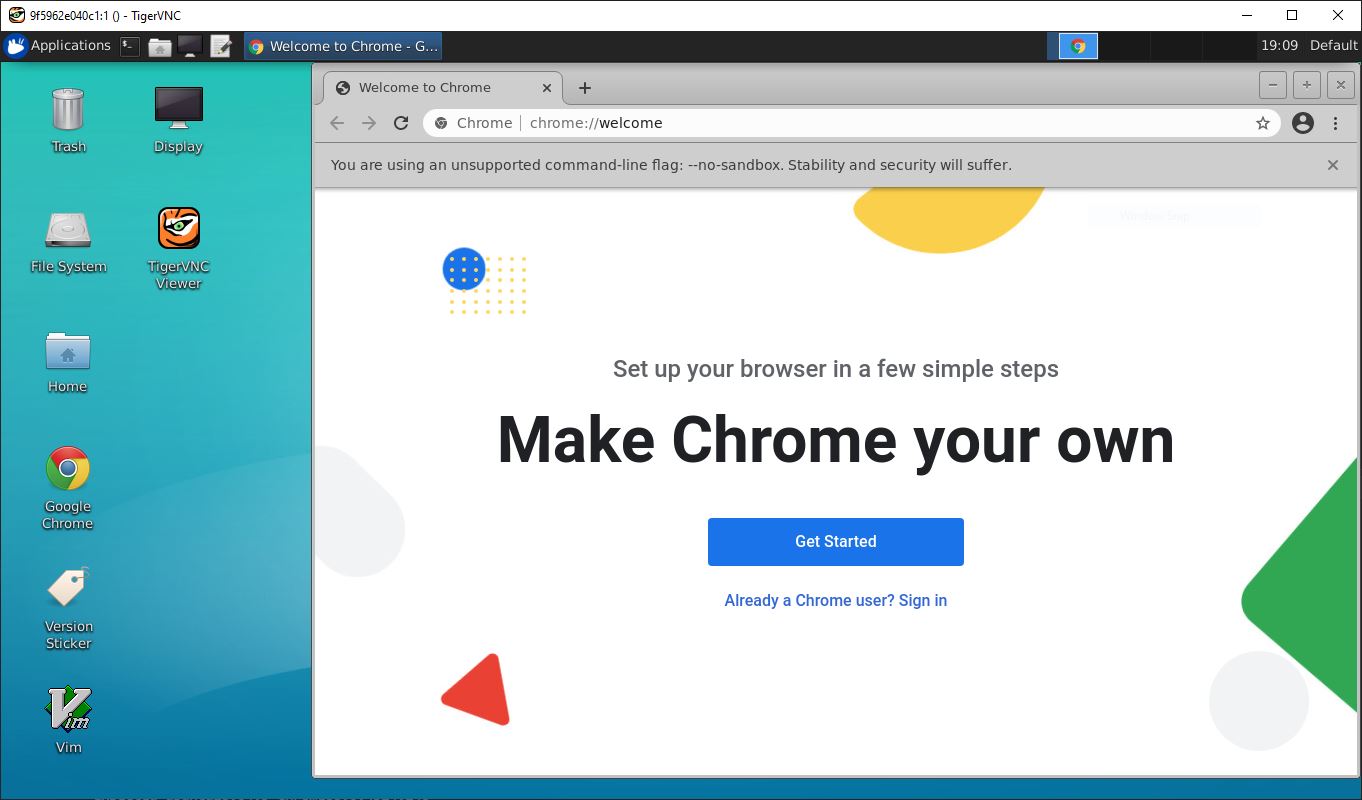Docker Hub - Git Hub - Changelog - Wiki - Hierarchy
Attention Google Chrome in this image runs in --no-sandbox mode. You should be aware of the implications. The image is intended for testing and development.
This repository contains resources for building Docker images based on Ubuntu 18.04 LTS with Xfce desktop environment, VNC/noVNC servers for headless use and the current Google Chrome web browser.
This is the second generation (G2) of my headless images, that I've retired back in March 2022. However, because I've noticed that the images are still pulled, I've revived the project in November 2022. The current second version (G2v2) brings some improvements, mostly in the building pipeline and supporting scripts.
If you want the newer images based on Ubuntu 20.04 LTS with the latest TigerVNC/noVNC versions, please check the third generation (G3) accetto/ubuntu-vnc-xfce-g3, accetto/ubuntu-vnc-xfce-chromium-g3 or accetto/ubuntu-vnc-xfce-firefox-g3.
The images are part of the growing image hierarchy and they are based on accetto/xubuntu-vnc-novnc. They inherit all the features and therefore not the whole description will be repeated here.
The latest image inherits among others
- utilities ping, wget, zip, unzip, sudo, curl, git (Ubuntu distribution)
- utility gdebi lets you install local
.debpackages resolving and installing their dependencies (Ubuntu distribution) - current version of JSON processor jq
- popular text editors vim and nano (Ubuntu distribution)
- lite but advanced graphical editor mousepad (Ubuntu distribution)
- xfce4-screenshooter and image viewer ristretto (Ubuntu distribution)
- current version of tini as the entry-point initial process (PID 1)
and adds
- current version of Google Chrome web browser
The history of notable changes is documented in the CHANGELOG.
The following image tags are regularly maintained and rebuilt:
The Git Hub repository contains the following Dockerfiles that can be used to build the images.
-
Dockerfile.chromeThis is the main Dockerfile for building the
latestimage tag based on theaccetto/xubuntu-vnc-novnc:latesttag by default.However, by providing the
BASETAGbuild argument it is possible to build images based on other base tags, for exampleaccetto/xubuntu-vnc-novnc:lab.
Following TCP ports are exposed:
- 5901 used for access over VNC
- 6901 used for access over noVNC
The containers do not create or use any external volumes by default. However, the following folders make good mounting points: /home/headless/Documents/, /home/headless/Downloads/, /home/headless/Pictures/, /home/headless/Public/
Both named volumes and bind mounts can be used. More about volumes can be found in the Docker documentation (e.g. Manage data in Docker).
Containers created from these images run under the non-root default application user (headless, 1001:0). However, the sudo command allows user elevation. For more description check the base image accetto/xubuntu-vnc-novnc or Wiki.
Version sticker serves multiple purposes that are closer described in Wiki. The version sticker value identifies the version of the docker image and it is persisted in it when it is built. It is also shown as a badge in the README file.
However, the script version_sticker.sh can be used anytime for convenient checking of the current versions of installed applications.
The script is deployed into the startup folder, which is defined by the environment variable STARTUPDIR with the default value of /dockerstartup.
If the script is executed inside a container without an argument, then it returns the current version sticker value of the container. This value is newly calculated and it is based on the current versions of the essential applications in the container.
The current version sticker value will differ from the persisted value, if any of the included application has been updated to another version.
If the script is called with the argument -v (lower case v), then it prints out verbose versions of the essential applications that are included in the version sticker value.
If it is called with the argument -V (upper case v), then it prints out verbose versions of some more applications.
Examples can be found in Wiki.
There are two ways, how to use the created headless containers. Please refer to the base image accetto/xubuntu-vnc-novnc to learn about them.
Note that the default VNC user password is headless.
If you have found a problem or you just have a question, please check the Issues and the Wiki first. Please do not overlook the closed issues.
If you do not find a solution, you can file a new issue. The better you describe the problem, the bigger the chance it'll be solved soon.
Credit goes to all the countless people and companies, who contribute to open source community and make so many dreamy things real.

